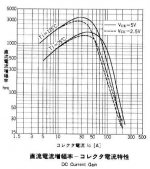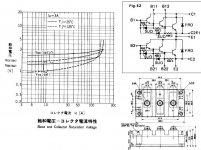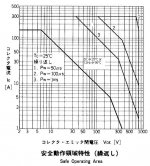ops...
5ohm at +/- 100V
2.5ohm at +/-100V f>=20hz (thanks to large termal time constant)
(pure resistive load..) Tcase=87.5 °C ( P istantaneus max =500W)
with efficiency = 0.5, r=5ohm, transistor must dissipate 500W
With P out = 1000W ( i need half or less)
5ohm at +/- 100V
2.5ohm at +/-100V f>=20hz (thanks to large termal time constant)
(pure resistive load..) Tcase=87.5 °C ( P istantaneus max =500W)
with efficiency = 0.5, r=5ohm, transistor must dissipate 500W
With P out = 1000W ( i need half or less)
That's a superb SOAR.dadouzzu said:Whit heat sink at 90°C, at 100V , DC condition
Ic=5A
With +/-100Vrail i can drive 6ohm resistive load in DC
or 3ohm at 20Hz
Power is not a problem for this device.
Q. How linear is it?
AndrewT said:That's a superb SOAR.
Power is not a problem for this device.
Q. How linear is it?
I don't know
I attach hfe graph
there are 3 npn transistor in darlington configuration but all base are connected to external pin
how can i check the linearity?
Attachments
Why don't you show the forward biased SOA graph?
The only one I found shows 300A at 10V , decreasing to a mere 5A at 100V on 10mS pulses (at 25°C), hardly suitable for a linear amplifier.
A single MJ21195 has 5.5A SOA at 100V at 10mS.
The only one I found shows 300A at 10V , decreasing to a mere 5A at 100V on 10mS pulses (at 25°C), hardly suitable for a linear amplifier.
A single MJ21195 has 5.5A SOA at 100V at 10mS.
djk said:Why don't you show the forward biased SOA graph?
The only one I found shows 300A at 10V , decreasing to a mere 5A at 100V on 10mS pulses (at 25°C), hardly suitable for a linear amplifier.
A single MJ21195 has 5.5A SOA at 100V at 10mS.
SOA is not a problem
have you see last attachment with case dimension? (108mm x 62mm with 6M bolted connections
 , no to247 or similiar)
, no to247 or similiar)5.5A*100V = 550W
My transistor Pdmax=1000W @25°C or 2000W 40ms 25°C
I attach SOA graph.
I have added DC limit based on Pmax & graphically derived second break down
how can i check linearity?
Attachments
AndrewT said:Darlington!
I would discard it.
I can connect the base of power transistor directly, but with LOW hfe...
I have added DC limit based on Pmax & graphically derived second break down
How can you derive DC second breakdown from a 1ms curve? I have never seen a BJT with a DC second breakdown knee above 100V before and I doubt this will have it.
Look at this switching part for example:
http://www.elfa.se/pdf/71/07113269.pdf
BUV298V - 250W / 450V / 50A
The DC second breakdown knee is at 12V. Yes - twelve volts for this 450V part. The SOA at 100V is 0.2A, 20W. The MJ21194 has TEN times this SOA at 100V, and they are rated at the same power!
Thank you for the graph, it clearly shows that this device has NO safe area for audio use.
These discontinued devices have great value used to the people that do maintenance on products they are used in, this device sells for over $100 used.
Sell it.
Take the money and buy some parts suited to an audio amplifier.
These discontinued devices have great value used to the people that do maintenance on products they are used in, this device sells for over $100 used.
Sell it.
Take the money and buy some parts suited to an audio amplifier.
Wow
What good advise....you don't get advise like that from most any other audio forums. They would tell you to go ahead and use them, they should be excellent for power. From a technical POV, these are not suited for linear operation, but if they are worth as much as djk states, I would be looking for a buyer if you have many of them...maybe the Vendor's Bazaar in this forum?

What good advise....you don't get advise like that from most any other audio forums. They would tell you to go ahead and use them, they should be excellent for power. From a technical POV, these are not suited for linear operation, but if they are worth as much as djk states, I would be looking for a buyer if you have many of them...maybe the Vendor's Bazaar in this forum?

- Status
- Not open for further replies.
- Home
- Amplifiers
- Solid State
- 150A 1000V bjt based amp possible?


